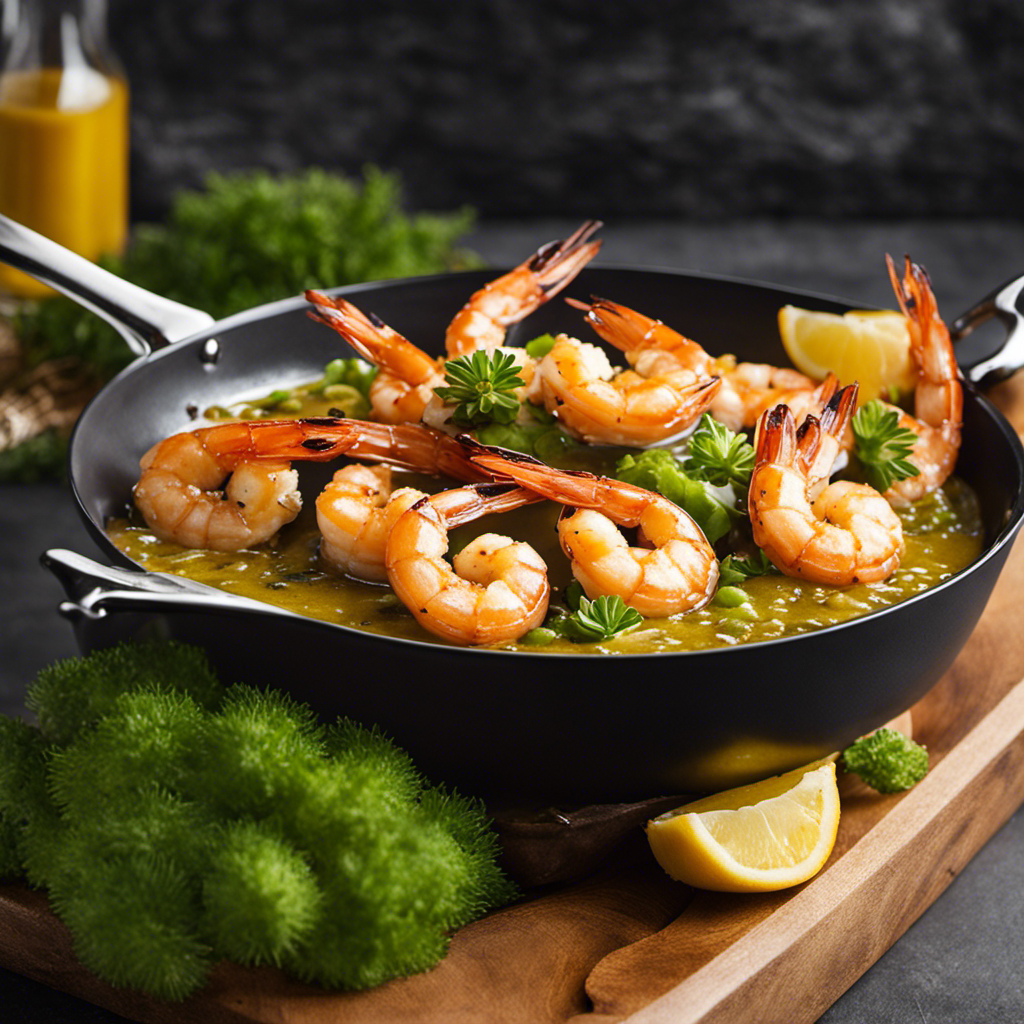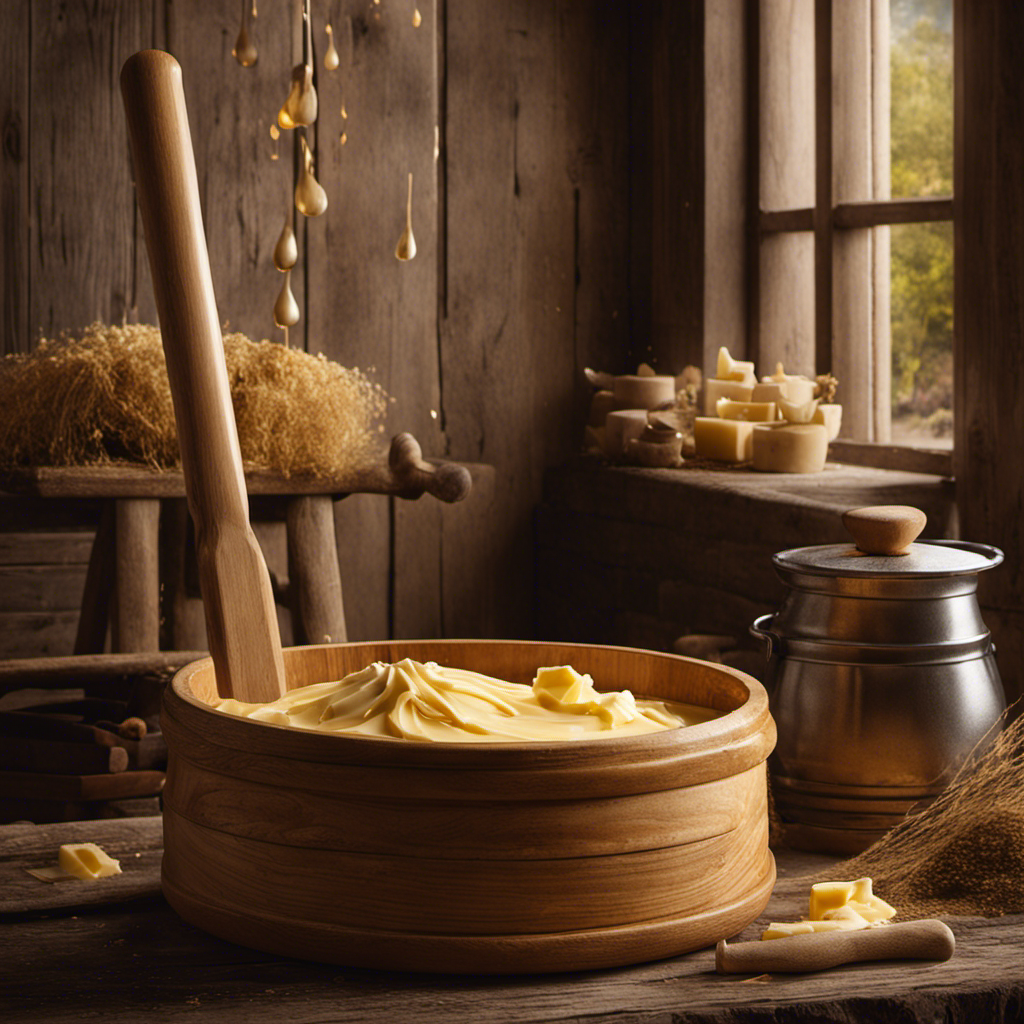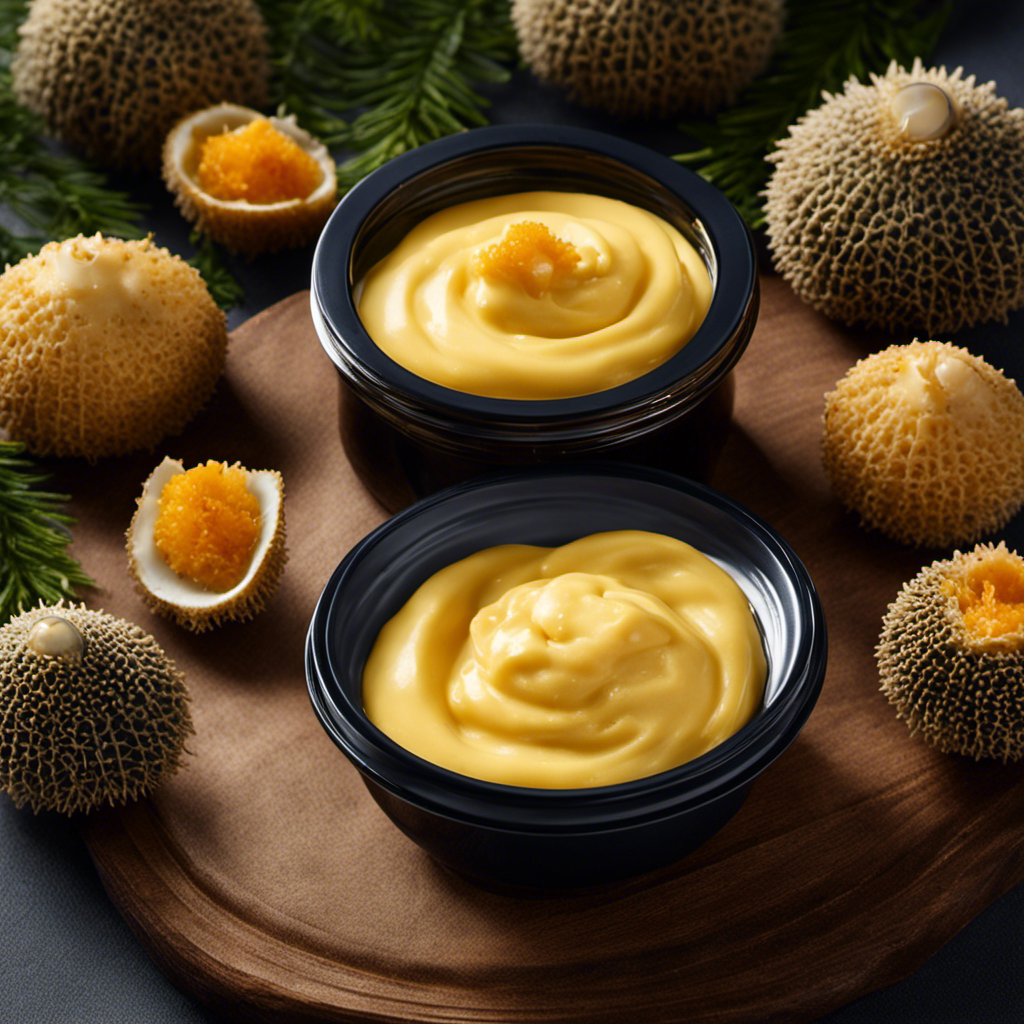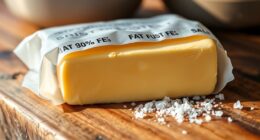I absolutely love butter sauce. It is the perfect accompaniment to many dishes, adding a rich and creamy flavor that is unmatched.
Imagine this: you’re sitting down to a perfectly seared steak, and as you take your first bite, a velvety butter sauce coats your palate, enhancing every delicious bite.
In this article, we’ll dive into the world of butter sauce, exploring its history, ingredients, variations, and even some tips and tricks for making the perfect batch.
Get ready to elevate your cooking with the magic of butter sauce.
Key Takeaways
- Butter sauce has a rich history dating back to ancient Rome and is a prominent feature in French and Indian cuisine.
- Cream is a main ingredient in butter sauce, adding richness and smoothness, and there are various variations such as hollandaise sauce and lemon butter sauce.
- Butter sauce enhances the flavor of dishes and adds a touch of luxury and indulgence to meals.
- Butter sauce is versatile and can be paired with a variety of proteins, used as a drizzle or dip, and even incorporated into desserts for a rich and decadent treat.
History of Butter Sauce
You might be surprised to learn that butter sauce has a rich history. Throughout time, this delectable sauce has evolved and gained cultural significance in various cuisines around the world.
Its origins can be traced back to ancient Rome, where the Romans would mix butter with various herbs and spices to create a flavorful sauce. Over the centuries, butter sauce has been adapted and modified by different cultures, each adding their own unique twist.
In French cuisine, the renowned Beurre Blanc sauce showcases the elegance and sophistication of butter. In Indian cuisine, the creamy and aromatic Makhani sauce, made with butter and spices, is a staple.
The evolution and cultural significance of butter sauce truly highlight its versatility and enduring popularity.
Ingredients Used in Butter Sauce
One of the main ingredients in butter sauce is cream. Cream adds richness and smoothness to the sauce, creating a velvety texture that enhances the flavors of the dish. Butter sauce can be used in a variety of ways, making it a versatile addition to any cook’s repertoire. It can be drizzled over steamed vegetables, grilled meats, or pasta dishes, adding a luxurious touch to each bite. The creamy texture of butter sauce also makes it perfect for dipping seafood, such as lobster or shrimp. Popular recipes that incorporate butter sauce include classic dishes like Lobster Thermidor and Chicken Francaise. The table below provides a visual representation of some of the different uses and popular recipes for butter sauce:
| Uses | Popular Recipes |
|---|---|
| Drizzled over steamed vegetables | Lobster Thermidor |
| Poured over grilled meats | Chicken Francaise |
| Tossed with pasta dishes | Shrimp Scampi |
| Used as a dip for seafood | Filet Mignon with Bearnaise |
Different Variations of Butter Sauce
There are several different variations of butter sauce that can add unique flavors to a variety of dishes. From a classic hollandaise sauce to a tangy lemon butter sauce, the possibilities are endless.
Butter sauces can be used in a multitude of ways, whether it’s drizzled over vegetables, poured over grilled meats, or used as a decadent dip for crusty bread.
Not only do these sauces enhance the taste of your favorite dishes, but they also offer health benefits. Butter is a good source of vitamins A, D, and E, as well as healthy fats that can help with brain function and hormone production.
Benefits of Using Butter Sauce in Cooking
Butter sauce is a culinary gem that can take your dishes to the next level. Its rich flavor enhancement adds a luxurious touch to any meal, making it a favorite among chefs and food enthusiasts alike.
Not only is butter sauce versatile in its ability to complement a variety of dishes, but it also provides a creamy texture enhancement that elevates the overall dining experience.
Rich Flavor Enhancement
To enhance the rich flavor of your dish, you can’t go wrong with adding a butter sauce. This flavorful sauce is a true game-changer in the culinary world.
The velvety texture and buttery goodness of the sauce elevate any dish to new heights. Whether it’s drizzling it over a juicy steak or tossing it with pasta, the butter sauce adds a touch of luxury and indulgence.
The combination of melted butter, herbs, and spices creates a symphony of flavors that dance on your taste buds. The richness of the butter enhances the natural flavors of the ingredients, creating a harmonious balance that is simply irresistible.
Versatile Cooking Ingredient
Adding a buttery sauce to a dish can truly transform its taste and take it to another level of deliciousness. Butter sauce is a versatile cooking ingredient that can be used in a variety of recipes to add richness, flavor, and depth.
Here are some popular butter sauce recipes that you can try at home:
-
Beurre Blanc: A classic French butter sauce made with white wine, vinegar, shallots, and, of course, butter. It’s perfect for seafood dishes like fish or scallops.
-
Hollandaise Sauce: This velvety sauce is made with clarified butter, egg yolks, lemon juice, and a pinch of cayenne pepper. It’s a must-have for eggs Benedict or asparagus.
-
Garlic Butter Sauce: A simple yet delicious sauce made with melted butter, minced garlic, and herbs. It’s great for drizzling over grilled meats or roasted vegetables.
-
Lemon Butter Sauce: This tangy sauce is made with butter, lemon juice, and zest. It pairs wonderfully with chicken or pasta dishes.
With these versatile butter sauce recipes, you can elevate any dish and impress your taste buds. So go ahead and get creative in the kitchen!
Creamy Texture Enhancement
Now that we’ve explored the versatility of butter sauce, let’s dive into its ability to enhance the creamy texture of dishes.
While butter itself provides a smooth and velvety mouthfeel, there are alternatives for those seeking a healthier option. Many chefs use ingredients like olive oil or coconut milk to achieve a similar creamy texture without the high saturated fat content of butter.
These alternatives not only add richness to the sauce but also offer a range of health benefits. Olive oil, for example, is rich in heart-healthy monounsaturated fats, while coconut milk provides a dose of healthy fats and essential minerals.
Incorporating these creamy texture alternatives into butter sauce allows you to enjoy the satisfaction of a velvety sauce while making mindful choices for your well-being.
Now, let’s explore how to make a basic butter sauce.
How to Make a Basic Butter Sauce
When it comes to making a delicious butter sauce, it’s all about the right ingredients. From a rich and creamy base of butter to the perfect blend of herbs and spices, each component plays a crucial role in creating the perfect flavor profile.
Once you have your ingredients ready, it’s time to master the cooking techniques that will take your butter sauce to the next level. Whether you’re looking for a silky smooth consistency or a slightly caramelized finish, there are various techniques you can use to achieve the desired result.
And if you’re feeling adventurous, don’t be afraid to experiment with different variations of butter sauce, such as adding a splash of citrus or a hint of heat, to elevate your dishes to new heights of deliciousness.
Ingredients for Butter Sauce
To make butter sauce, you’ll need butter, garlic, lemon juice, and salt. This versatile sauce is a staple in many kitchens due to its rich and creamy flavor. It can be used in various cooking techniques, whether as a simple drizzle over steamed vegetables or a decadent accompaniment to grilled seafood.
The combination of butter and garlic creates a savory base, while the lemon juice adds a bright and tangy note. The addition of salt enhances the flavors and balances the richness of the butter.
When it comes to flavor pairings, butter sauce complements a wide range of dishes, including roasted chicken, pasta, and even grilled steak. Its velvety texture and luxurious taste make it a go-to sauce for elevating any meal.
So, grab your ingredients and get ready to indulge in the creamy goodness of homemade butter sauce.
- Drizzle over roasted vegetables for a burst of flavor.
- Pair with grilled shrimp for a delicious seafood dish.
- Toss with fresh pasta and herbs for a quick and satisfying meal.
- Use as a dipping sauce for crusty bread or as a topping for baked potatoes.
Cooking Techniques for Butter Sauce
One popular technique for cooking butter sauce is melting the ingredients together in a saucepan. This technique allows the flavors to mingle and develop, creating a rich and creamy sauce.
To start, I melt butter in a saucepan over low heat until it becomes a golden liquid. Then, I add in minced garlic and let it cook for a minute until fragrant.
Next, I pour in a splash of lemon juice and a pinch of salt, which enhances the flavor profile of the sauce. I continue to stir the mixture until it thickens slightly.
This cooking technique ensures that the butter sauce is smooth and flavorful, perfect for drizzling over grilled vegetables or seafood.
Variations of Butter Sauce
There are various ways to modify butter sauce to suit different dishes and tastes. Whether you prefer a classic beurre blanc or a spicy garlic butter, there is a butter sauce for every palate. Here are some variations of butter sauce that you can try:
-
Lemon Butter Sauce: This tangy and refreshing sauce is perfect for seafood dishes like grilled shrimp or pan-seared scallops.
-
Herb Butter Sauce: Infused with fresh herbs like parsley, thyme, and rosemary, this sauce adds a burst of flavor to grilled meats and roasted vegetables.
-
Hollandaise Sauce: A rich and creamy sauce made with clarified butter, egg yolks, and lemon juice, it is a classic accompaniment to eggs Benedict and asparagus.
-
Béarnaise Sauce: Similar to hollandaise but with the addition of tarragon and shallots, this sauce pairs beautifully with steak and roasted potatoes.
With so many different butter sauces to choose from, you can elevate your favorite dishes to new heights of deliciousness.
Now, let’s move on to some tips and tricks for perfecting butter sauce.
Tips and Tricks for Perfecting Butter Sauce
If you want to perfect your butter sauce, try adding a splash of lemon juice for a zesty twist.
Perfecting butter sauce can be tricky, but with a few tips and tricks, you can create a velvety and flavorful sauce every time.
One of the most common mistakes in making butter sauce is overheating the butter. It’s important to melt the butter slowly over low heat to prevent it from browning or burning.
Another mistake is not emulsifying the sauce properly. To avoid separation, whisk the butter into the sauce gradually, allowing it to incorporate fully before adding more.
Lastly, adding too much salt can overpower the delicate flavors of the sauce, so it’s best to season it lightly and adjust to taste.
Now that you’ve mastered the art of making butter sauce, let’s explore how to pair it with various dishes.
Pairing Butter Sauce With Various Dishes
To enhance the flavors of your dishes, consider pairing your velvety and flavorful butter sauce with a variety of proteins such as grilled chicken or seared fish. The rich and creamy texture of the butter sauce complements the delicate flavors of seafood, creating a mouthwatering combination.
Here are some creative uses for butter sauce in desserts:
- Drizzle it over warm, freshly baked pastries for a decadent twist.
- Use it as a base for a luscious caramel sauce to pour over ice cream.
- Whip it into a fluffy buttercream frosting to elevate your cakes and cupcakes.
- Add a dollop of butter sauce to your pancake or waffle batter for a rich and indulgent breakfast treat.
Frequently Asked Questions About Butter Sauce
Have you ever wondered how long you can store butter sauce in the refrigerator before it goes bad? Well, let me clear up some common misconceptions for you.
Contrary to what some may think, butter sauce can actually be stored in the refrigerator for up to two weeks. However, it’s important to note that the quality and taste may start to deteriorate after the first few days. So, it’s best to consume it within the first week for the best flavor.
Now, onto the health benefits of butter sauce. While it’s true that butter sauce is high in calories and fat, it also contains essential nutrients like vitamin A and vitamin E. Moderation is key when it comes to enjoying this delicious sauce. So go ahead, indulge and savor the flavors, but remember to use it in moderation.
Frequently Asked Questions
Is Butter Sauce Suitable for People With Lactose Intolerance?
Butter sauce is not suitable for people with lactose intolerance due to its high lactose content. However, there are alternatives available such as using lactose-free butter or other non-dairy options for cooking.
Can I Use Margarine Instead of Butter to Make Butter Sauce?
Sure, you can use margarine as a substitute for butter in making butter sauce. However, keep in mind that there may be a difference in flavor. Margarine tends to have a slightly different taste compared to butter.
How Long Can I Store Butter Sauce in the Refrigerator?
Butter sauce can be stored in the refrigerator for up to 5 days. To ensure its freshness, store it in an airtight container. It’s important to check for any signs of spoilage before using.
Can I Freeze Butter Sauce for Later Use?
Yes, you can freeze butter sauce for later use. It’s a great way to extend its shelf life. When thawed, it may separate, but simply whisk it back together. Use it as a flavorful addition to pasta, vegetables, or meats.
Is Butter Sauce High in Calories?
Butter sauce can be high in calories if consumed in excess, but when used in moderation, it can provide health benefits. To make a low-calorie version, try using light butter or substituting with olive oil and herbs for flavor.
Conclusion
In conclusion, butter sauce is a culinary masterpiece that adds richness, flavor, and depth to any dish. It is like the golden key that unlocks a world of possibilities in the kitchen.
Just as a skilled artist uses different strokes to create a masterpiece, different variations of butter sauce can transform a simple meal into a work of art.
So next time you’re in the kitchen, don’t forget to wield the power of butter sauce and watch as your dishes come to life in a symphony of taste and texture.









